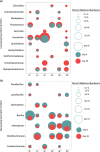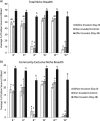The impact of failure: unsuccessful bacterial invasions steer the soil microbial community away from the invader's niche
- PMID: 29374268
- PMCID: PMC5864238
- DOI: 10.1038/s41396-017-0003-y
The impact of failure: unsuccessful bacterial invasions steer the soil microbial community away from the invader's niche
Abstract
Although many environments like soils are constantly subjected to invasion by alien microbes, invaders usually fail to succeed, succumbing to the robust diversity often found in nature. So far, only successful invasions have been explored, and it remains unknown to what extent an unsuccessful invasion can impact resident communities. Here we hypothesized that unsuccessful invasions can cause impacts to soil functioning by decreasing the diversity and niche breadth of resident bacterial communities, which could cause shifts to community composition and niche structure-an effect that is likely exacerbated when diversity is compromised. To examine this question, diversity gradients of soil microbial communities were subjected to invasion by the frequent, yet oft-unsuccessful soil invader, Escherichia coli, and evaluated for changes to diversity, bacterial community composition, niche breadth, and niche structure. Contrary to expectations, diversity and niche breadth increased across treatments upon invasion. Community composition and niche structure were also altered, with shifts of niche structure revealing an escape by the resident community away from the invader's resources. Importantly, the extent of the escape varied in response to the community's diversity, where less diverse communities experienced larger shifts. Thus, although transient and unsuccessful, the invader competed for resources with resident species and caused tangible impacts that modified both the diversity and functioning of resident communities, which can likely generate a legacy effect that influences future invasion attempts.
Conflict of interest statement
The authors declare that they have no competing interests.
Figures






References
-
- Kumschick S, Gaertner M, Vilà M, Essl F, Jeschke JM, Pyšek P, et al. Ecological impacts of alien species: quantification, scope, caveats, and recommendations. Bioscience. 2014;65:55–63. doi: 10.1093/biosci/biu193. - DOI
-
- Elton C. Ecology of Invasions by Animals and Plants. US: Springer; 1958.
Publication types
MeSH terms
Substances
Grants and funding
LinkOut - more resources
Full Text Sources
Other Literature Sources

